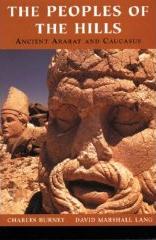
The Peoples of the Hills
Charles Burney,
David Marshall Lang
324 pages including index
published in 1971
I picked up The Peoples of the Hills because I wanted to know more about the history of the caucasus in general and Armenia in particular, mainly because Doug of Halfway Down the Danube had been blogging about his being stationed there. He had been posting about some of Armenia's history and it seemed interesting. Since I knew next to nothing about any of the history, espcially the early history of Armenia, Georgia and the Caucasus, The Peoples of the Hills seemed a good start.
Unfortunately however it disappointed. For a start, I didn't realise how dated it was, having originally been written in 1971 and reprinted for the History of Civilization series published by Phoenix Press. Not that there was much choice in the library I picked this up: it was this or nothing. In thirty years a lot can change and I've found that on the whole more modern history books are preferable to older ones (this is not an absolute rule of course). But what also disappointed me was the writing itself. This is, unfortunately, a very dull book, full of facts but lacking sparkle.
Let me be clear. I can handle difficult books, I don't need a Armenian History for Dummies and I understand that perhaps you cannot have a more narrative orientated history of this region without lying by omission, as so much is still unknown about its early history. Many of the peoples living there were either pre-literate or did not leave writing on materials sturdy enough to withstand the rigors of time, so there are far fewer usuable sources than there are for e.g. the classical Greek or Roman civilisations. I understand the handicaps the authors are working under.
But still. The first half especially, written by archaeologist Charles Burney takes you through a bewildering succession of archaeological findings inhabitated by people you've never heard of, with the occasional extract from other peoples' histories when they came into contact with more well known civilisations, like the Assyrian.
The second half of the book, which picks up the story from the founding of Armenia and Georgia as separate countries, through classical times into early Christianity, ending in roughly late Medieval times is more coherent. It benefits from being written by a historian, David Marshall Lang, and having les emphasis on archaeological findings.
What remains is the sense of deep history of these parts. I myself live in a country that can barely trace its own history back to Roman times, while most of its cities were only founded in Medieval times. It's hard to imagine that when the oldest cities in the Netherlands were brand spanking new Roman settlements, there had been cities in the Caucasus and Eastern Turkey that had already been abandoned hundreds of years before, after having existed for a thousand years or more. What's more, despite its flaws, The Peoples of the Hills does impress you with the fact that this history was far from static. That's a fallacy that it took me a long time to get over, so I'm always pleased to see a history book attack it.
Read more about:
Charles Burney,
David Marshall Lang,
The Peoples of the Hills,
Armenia,
Georgia,
archaeology,
history,
book review